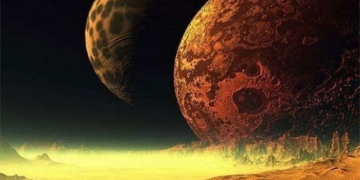Scientists have just discovered the most deadly planet ever observed in the history of astronomy: Kepler-1658b, located 2,600 light-years away from Earth.
According to Science Alert and SciTech Daily, researcher Shreyas Vissapragada from the Harvard-Smithsonian Center for Astrophysics and colleagues found something unusual about Kepler-1658b: It is spiraling towards its star instead of following a stable orbit.
This anomaly will inevitably lead to a catastrophic fate: plunging directly into its parent star and ultimately vanishing in fierce flames.

Graphic depiction of the hot Jupiter Kepler-1658b on its bizarre spiral path toward its parent star – (Image: Instituto de Astrofísica de Canarias)
The planet’s brutal demise is estimated to occur within the next 3 million years, a time span that may seem long to humanity but is merely a blink of an eye in the history of planets.
What is happening to it is a catastrophic tidal interaction that massive planets orbiting too close to their parent stars can encounter. The intense gravitational forces from both will pull them together, but it is certain that the planet, being significantly smaller than its star, will be the one consumed.
Currently, Kepler-1658b orbits its parent star at a distance of just 1/8 of the distance from the Sun to Mercury. Each orbit around its star takes less than 3 days and is shortening by about 131 milliseconds each year.
Kepler-1658b is classified as a “hot Jupiter,” meaning it is a massive gas giant that is scorching hot due to its proximity to its star. However, it is likely that it will soon have its entire atmosphere stripped away by the star, becoming a small, iron-rich body the size of Earth before its demise.
Its aging parent star is also in the process of expanding into a red giant – the final glorious phase of stars as they run out of energy. This brings the planet and star even closer together, pulling on each other more fiercely than before, which may also explain how this old planet was yanked from its stable orbit.
Even more terrifying, this planet may reflect our future. It is estimated that in 5 billion years, the Sun will reach the red giant stage, expanding enough to engulf the three planets closest to it: Mercury, Venus, and Earth.


















































